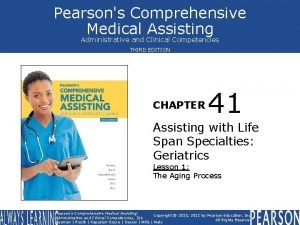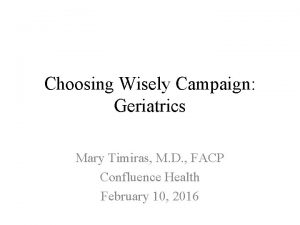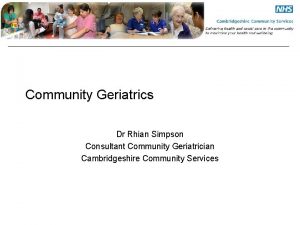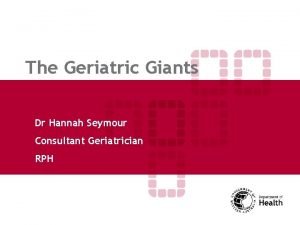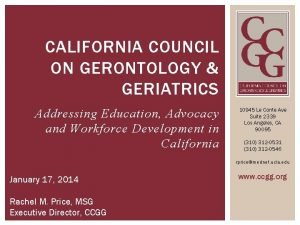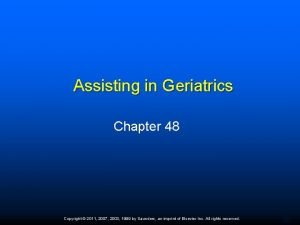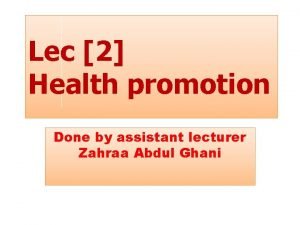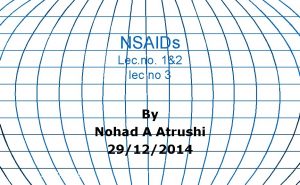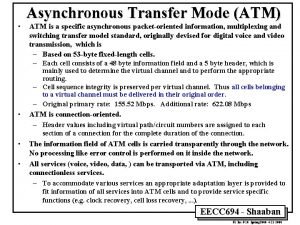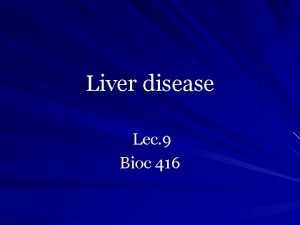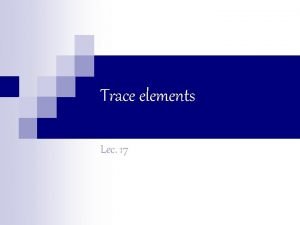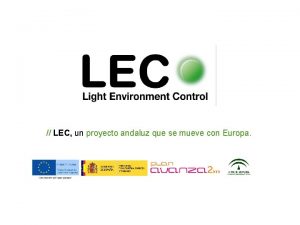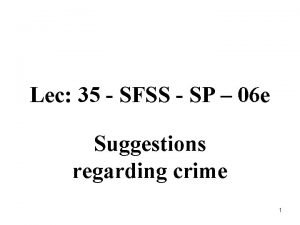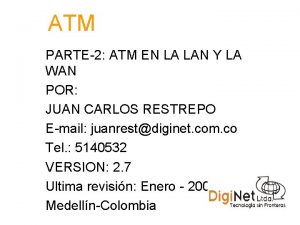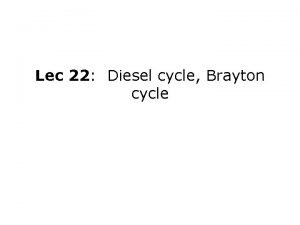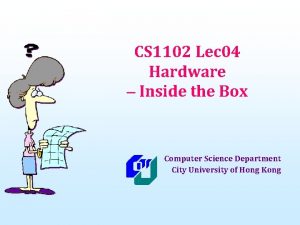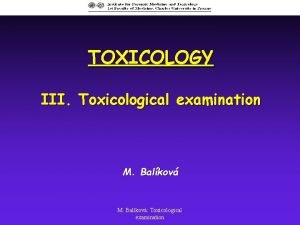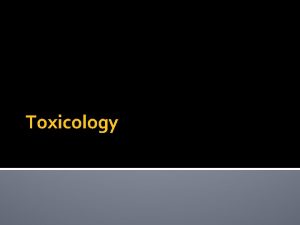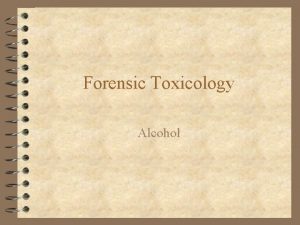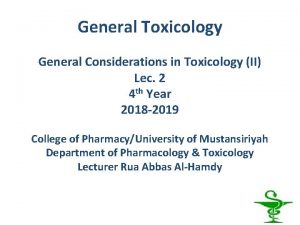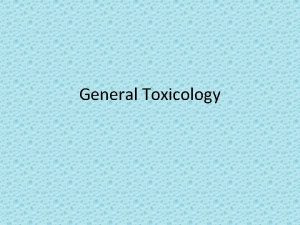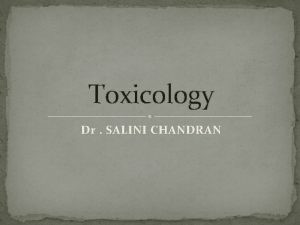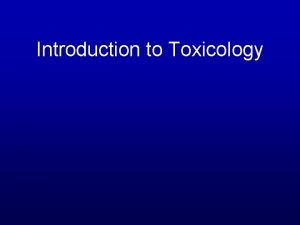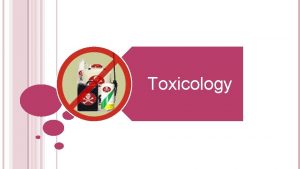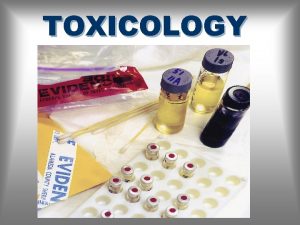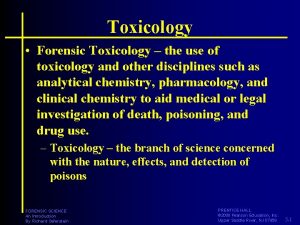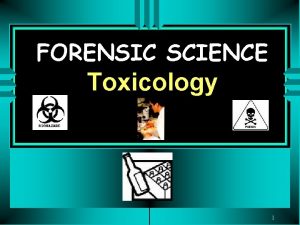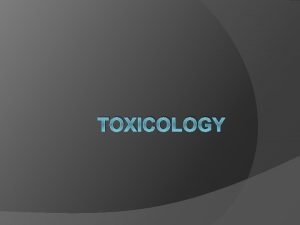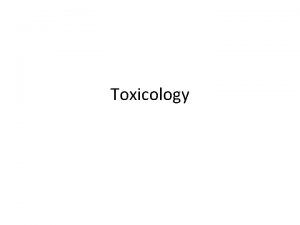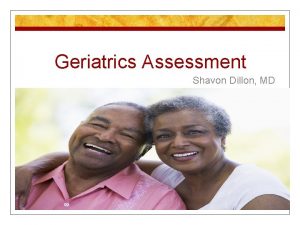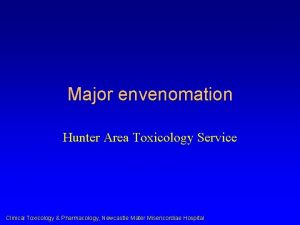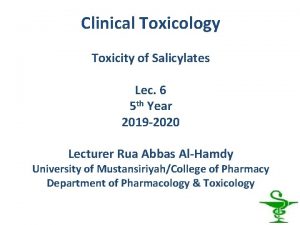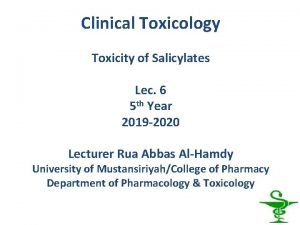Clinical Toxicology Toxicological Considerations in Pediatrics Geriatrics Lec

































- Slides: 33

Clinical Toxicology Toxicological Considerations in Pediatrics & Geriatrics Lec. 4 5 th Year 2019 -2020 University of Mustansiriyah/College of Pharmacy Department of Pharmacology & Toxicology Lecturer Rua Abbas Al-Hamdy

Objectives of lecture: Objectives of this lecture are to determine causes of toxicity in pediatric patients & geriatric patients , & to identify specific toxicological considerations in each population.

Toxicological considerations in pediatrics: § An oversimplification of the etiology of childhood poisonings would be the formulation that unobserved toddlers exploring their environment inadvertently ingest xenobiotics. § The problem of unintentional ingestions is compounded by poison “look-alikes, ” that is, xenobiotics that resemble candy or food products.

Some common examples: Ferrous sulfate tablets & vitamins look like common candies. Many shampoos & dishwashing detergents are given lemon or strawberry scents & have pictures of fruits on the labels.

§ As children develop socially, they desire to become more like their parents, & they tend to imitate behaviors, such as taking medicine or using mouthwash. § Children are taught that medicine is good for them when they are sick. Many children’s medicines are sweetened & flavored to make them more palatable, & many parents inappropriately encourage their children to take medicines by telling them “it tastes like candy. ”

§ As children become more mobile, & curious, xenobiotics that were previously outside their reach become accessible, even when stored in some difficult-to-reach places. § Many of the kerosene exposures reported from developing countries occur because the kerosene is stored in water bottles, jugs, or other containers in easily accessible locations.

§ Medication errors also affect children. The most common error attributed to physicians is prescription of an incorrect dose. § Poisoning of children could be intentional, though unusual but significant form of child abuse.

Gastrointestinal decontamination: • As described above, children generally ingest small quantities of single xenobiotics. For most of these ingestions, gastric emptying is unnecessary. § Orogastric lavage is the preferred method of gastric emptying when indicated for most serious ingestions. § Placement of an orogastric tube is an unpleasant & frightening procedure for an infant or small child to undergo.

§ Some local trauma may result from tube placement &, rarely, there may be more serious injury, such as esophageal perforation. Also, many children vomit during placement of an orogastric tube. § The patient should be intubated to protect the airway before orogastric lavage is used in a child with a diminished gag reflex or a depressed level of consciousness.

§ Although syrup of ipecac is highly effective at making children vomit, the efficacy of preventing morbidity after an ingestion is questionable. § Activated charcoal is a current mainstay of poison treatment in the emergency department. Children generally will not drink AC willingly, although some children can be coaxed to do so if the AC is disguised in a baby bottle or soft drink container or sweetened with juice or sorbitol.

§ A nasogastric or orogastric tube may have to be inserted to administer AC. For AC to be used safely in a patient who is comatose & who does not have a gag reflex, the patient should be intubated & the airway protected. Because of this risk, AC alone is unnecessary for a nontoxic or minimally toxic ingestion.

Methods of enhanced elimination: § For consequential poisoning with xenobiotics such as methanol, ethylene glycol, salicylates, lithium, & theophylline, either hemodialysis or charcoal hemoperfusion is the optimal technique to enhance elimination, depending on the particular xenobiotic. The primary limiting factor is the ability to obtain vascular access. § Exchange transfusion is occasionally used to enhance xenobiotic elimination.

§ Exchange transfusion might be useful when multiple-dose AC cannot be administered, the xenobiotic is poorly adsorbed to charcoal, or access to specialized hemodialysis or hemoperfusion is not readily available. § Exchange transfusion has been used successfully for poisoning by salicylates , & theophylline.

Xenobiotics that may be toxic or fatal in small quantities: § When children ingest even small quantities of toxic xenobiotics, they are potentially ingesting large relative doses because of their small size. § There a number of xenobiotics that may cause significant toxicity or even death with as little as one pill or one teaspoonful. These xenobiotics are listed in Table 1.

Table 1. Xenobiotics that may cause severe toxicity to an infant after a small adult dose, a single pill or a small volume

Xenobiotics that cause unusual reaction in children: § Benzyl alcohol: gasping syndrome § Chloramphenicol: gray baby syndrome

Benzyl alcohol: gasping syndrome § Benzyl alcohol is a preservative added to liquid pharmaceutical preparations; for small-volume medications administered to adults, the benzyl alcohol additive is quite safe. § At toxic doses, benzyl alcohol may cause respiratory failure, vasodilation, hypotension, convulsions, and paralysis. § Intravenous flushing solutions containing benzyl alcohol were implicated as the cause of the “gasping syndrome” in sick newborns.

Benzyl alcohol: gasping syndrome § Gasping syndrome includes severe metabolic acidosis, encephalopathy, respiratory depression, & gasping. § Benzyl alcohol is metabolized by the conjugation of benzoic acid with glycine to form hippuric acid; this pathway may not be functional in premature infants. § Benzyl alcohol administration has also been associated with kernicterus & intraventricular hemorrhage in premature infants.

Chloramphenicol: Gray baby syndrome: • Chloramphenicol is a broad-spectrum antibiotic that has been used in pediatrics because of its activity against Haemophilus influenzae. It has largely been replaced by other antibiotics in the United States because of its association with aplastic anemia. • When administered at high doses, chloramphenicol can produce the “gray baby syndrome, ” which includes abdominal distension, vomiting, metabolic acidosis, progressive pallid cyanosis, irregular respirations, hypothermia, hypotension, & vasomotor collapse.

§ Although these effects occur primarily in premature newborn infants, they may also occur in older children & adults. • Gray baby syndrome is associated with serum concentrations greater than 100 mg/L. Increased chloramphenicol concentrations may result from: • inadequate conjugation of chloramphenicol with glucuronic acid because of inadequate activity of glucuronyl transferase in the newborn liver, & • decreased renal elimination of unconjugated chloramphenicol.

§ The exact mechanism of toxicity is unknown; there is speculation that free radicals formation produced may interfere with mitochondrial function.

Toxicological considerations in geriatrics: How could toxicity occur in geriatrics? § Suicide & intentional poisonings: The risk of suicide by all methods increases steadily with age, particularly among men. § Unintentional poisoning, adverse drug events (ADEs): • Although poisoning exposures are much less frequent in the elderly than in other age groups, the incidence of ADEs among adults increases steadily with age & increases steeply from age 65 years through the tenth decade of

• An ADE is defined as “one that occurs with normal, prescribed, labeled or recommended use of the drug. • ADEs are more likely to be serious in the elderly than in younger adults. Age-related factors involved in enhanced susceptibility to ADEs are given in Table 2.

Table 2. Pharmacokinetic considerations in the elderly

• The likelihood of experiencing an ADE increases with the increasing number of xenobiotics taken. ADEs may occur as a consequence of xenobiotic–xenobiotic interactions. • Xenobiotics, such as digoxin, warfarin, & diuretics, commonly prescribed in the elderly population are frequently involved in serious drug interactions. • Herbal preparations used by the elderly also may interact with prescription medications.

• Virtually all of the most popular nonprescription medications are more likely to produce problems in the elderly than in younger patients, including GI bleeding (aspirin & other NSAIDs), enhanced warfarin sensitivity (cimetidine), confusion & urinary retention (anticholinergic antihistamines), & cardiovascular symptoms (pseudoephedrine). § Other age-related factors may increase the risk of unintentional poisonings in geriatric patients; impaired vision, hearing, & memory may lead to misunderstanding or an inability to follow directions concerning the drugs use.

§ Exposures in persons older than age 60 years are more likely the result of therapeutic errors & “misuse” than in younger adults. A therapeutic error is defined as “an unintentional deviation from a proper therapeutic regimen that results in the wrong dose, incorrect route of administration, administration to the wrong person, or administration of the wrong substance” & includes “unintentional administration of xenobiotics or foods which are known to interact. ”

These age-related differences may be because of physiologic changes that affect xenobiotic disposition or effect, patient errors caused by cognitive or visual impairment, or lack of provider proficiency in geriatric prescribing principles. Pharmacokinetic Considerations in the Elderly

§ Substance abuse in the elderly: Alcohol is the most common substance of abuse in people older than age 65 years. The most common xenobiotics detected in the elderly were benzodiazepines, opioids, & barbiturates, which, like alcohol, are more likely to impair older than younger adults.

Management: § GI decontamination should proceed as in younger patients. § Because constipation is a more frequent problem in the elderly, when multiple-dose activated charcoal is used, particular attention must be paid to GI function &motility. § The presence of clinical or subclinical heart failure or renal failure may increase the risk of fluid overload when sodium bicarbonate is used.

§ In the elderly, hemodialysis or hemoperfusion may be indicated earlier in cases of aspirin, lithium, or theophylline poisoning, in which elimination may be hampered by reduced clearance. § Strategies to limit unintentional toxic exposures in elderly patients with cognitive or sensory impairment should be similar to those used in young children, who are also at high risk of ingesting toxic substances or pharmaceuticals prescribed for others in the household.

The strategies should include the removal of potentially dangerous substances & unnecessary xenobiotics from the patient’s environment. The physician should make an effort to limit the number of medications prescribed or to seek alternative medications with appropriate geriatric safety profile. Administration & control of the medications by directly observed therapy may, of necessity, become the responsibility of the caregiver rather than the patient. .

 Pearson's comprehensive medical assisting
Pearson's comprehensive medical assisting Choosing wisely geriatrics
Choosing wisely geriatrics Community geriatrics
Community geriatrics Giants of geriatrics
Giants of geriatrics Einstein geriatrics
Einstein geriatrics California council on gerontology and geriatrics
California council on gerontology and geriatrics Einstein geriatrics
Einstein geriatrics Chapter 41 assisting in geriatrics
Chapter 41 assisting in geriatrics Sekisui slec
Sekisui slec Underground pipeline for irrigation
Underground pipeline for irrigation 11th chemistry thermodynamics lec 10
11th chemistry thermodynamics lec 10 Lec promotion
Lec promotion Xyloprin
Xyloprin 132000 lec
132000 lec Lec ditto
Lec ditto 252 lec
252 lec 416 lec
416 lec 1 lec
1 lec Elements lec
Elements lec Lecsl
Lecsl Lec anatomia
Lec anatomia Ir.ac.kashanu.register://h
Ir.ac.kashanu.register://h Scoreboarding computer architecture
Scoreboarding computer architecture Lec
Lec Art 455 lec
Art 455 lec Scoreboard computer architecture
Scoreboard computer architecture Lec hardver
Lec hardver History of software development life cycle
History of software development life cycle Tura analítica
Tura analítica Componentes del lec
Componentes del lec August lec 250
August lec 250 Brayton
Brayton Lec
Lec 11th chemistry thermodynamics lec 13
11th chemistry thermodynamics lec 13
